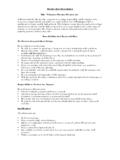Transcription of 2009 Breastfeeding Report Card
1 As measures of a state s ability to protect, promote, and support Breastfeeding , the Report card indicators show where a state has been successful and where more work is needed. Breastfeeding Report card United States, 2009 Improving the health of mothers and their children is a primary goal of the Centers for Disease Control and Prevention (CDC). Protecting, promoting, and supporting Breastfeeding , with its many known benefits for infants, children, and mothers, is a key strategy toward this goal. Throughout your community, everyone plays a role in fostering Breastfeeding . When health care professionals, legislators, employers, business owners, and community and family members work together, their efforts can increase the number of women who are able to start Breastfeeding and the length of time they continue to breastfeed.
2 The 2009 Breastfeeding Report card shows how Breastfeeding is being protected, promoted, and supported in each state* using five outcome and nine process indicators. This allows you to make comparisons across states and indicators and work to increase Breastfeeding nationwide. The five outcome indicators are derived from the Breastfeeding goals outlined in Healthy People 2010, a description of the nation s health priorities. They profile the extent to which infants in a state are breastfed. The nine process indicators measure elements of Breastfeeding -friendly communities. Each indicator is measured in every state, allowing easy state-by-state comparisons. OUTCOME INDICATORS The five outcome indicators directly track the Healthy People 2010 Breastfeeding objectives.
3 Outcomes are estimated using data from the annual CDC National Immunization Survey (NIS). PROCESS INDICATORS The nine process indicators measure five different types of Breastfeeding support: birth facility support; professional support; mother-to-mother support; state legislation; and public infrastructure (public facilities and services). The Breastfeeding Report card can help you: Tell the story of Breastfeeding practices in your state. Monitor progress and celebrate state successes. Identify opportunities for growth and improvement in Breastfeeding protection, promotion, and support within your state. * All references to states include the District of Columbia and the 50 US States.
4 Breastfeeding Report card - United States, 2009 StateEver BreastfedBreastfeeding at 6 monthsBreastfeeding at 12 monthsExclusive Breastfeeding at 3 monthsExclusive Breastfeeding at 6 of : Percents in bold are those that have met the Healthy People 2010 goal. Source: Centers for Disease Control and Prevention National Immunization Survey, Provisional Data, 2006 births. of Nutrition, Physical Activity, and ObesityNational Center for Chronic Disease Prevention and Health PromotionCenters for Disease Control and PreventionAtlanta, GA USAA ugust, 2009 Breastfeeding Report card - United States, NationalAlabamaAlaskaArizonaArkansasCali forniaColoradoConnecticutDelawareDist of ColumbiaFloridaGeorgiaHawaiiIdahoIllinoi sIndianaIowaKansasKentuckyLouisianaMaine MarylandMassachusettsMichiganMinnesotaMi ssissippiMissouriMontanaNebraskaNevadaNe w HampshireNew JerseyNew MexicoNew YorkNorth CarolinaNorth DakotaOhioOklahomaOregonPennsylvaniaRhod e IslandSouth CarolinaSouth DakotaTennesseeTexasUtahVermontVirginiaW ashingtonWest VirginiaWisconsinWyomingAverage mPINC ScorePercent of live births occuring at facilities designated as Baby Friendly (BFHI)
5 Percent of breastfed infants receiving formula before 2 days of ageNumber of IBCLCs* per 1,000 live birthsNumber of La Leche League groups per 1,000 live birthsNumber of state health department FTEs** dedicated to breastfeedingState legislation about Breastfeeding in public placesState legislation mandating^ employer lactation supportBreastfeeding coalition with public ^State requires employers to provide space and time for lactation. **FTE - Full-TimeEquivalent. * IBCLC - International Board Certified Lactation Consultant. Division of Nutrition, Physical Activity, and ObesityNational Center for Chronic Disease Prevention and Health PromotionCenters for Disease Control and PreventionAtlanta, GA USAA ugust, 2009 Healthy People 2010 Targets Objective 16-19 Increase the proportion of mothers who breastfeed their babies.
6 In early postpartum to 75% At 6 months to 50% At 12 months to 25% Exclusively through 3 months to 40% Exclusively through 6 months to 17% Breastfeeding Report card Indicators 2009 Birth Facility Support State mPINC score Percent of live births occurring at facilities identified as part of the Baby-Friendly Hospital Initiative Percent of breastfed infants receiving formula before 2 days of age Birth facility policies and practices significantly impact whether a woman chooses to start Breastfeeding and how long she continues to breastfeed. Several specific policies and practices, in combination, determine how much overall support for Breastfeeding a woman birthing in a given facility is likely to receive and how likely her baby is to receive formula in the first 2 days.
7 Two initiatives, one national and one global, provide informative measures of birth facility support. The Maternity Practices in Infant Nutrition and Care (mPINC) Survey, initiated by CDC, in collaboration with the Battelle Centers for Public Health Research and Evaluation in 2007, measures Breastfeeding -related maternity care practices at intrapartum care facilities across the United States and compares the extent to which these practices vary by state. Thus, the state mPINC score represents the extent to which each state s birth facilities provide maternity care that supports Breastfeeding . The Baby-Friendly Hospital Initiative (BFHI) is a global program sponsored by the World Health Organization (WHO) and the United Nations Children s Fund (UNICEF) to encourage and recognize hospitals and birthing centers that offer an optimal level of care for lactation based on the WHO/UNICEF Ten Steps to Successful Breastfeeding for Hospitals.
8 To be designated as Baby-Friendly, facilities undergo external evaluation to demonstrate that the facility meets all of the Ten Steps requirements. All types and sizes of birth facilities can seek the Baby-Friendly designation. Some states have several small Baby-Friendly facilities, others have only one or two large ones, and still others have none at all. Because facilities vary in size and the number of births, measuring their impact on public health requires more than just counting the number of Baby-Friendly facilities per state. The best way to measure their impact is to look at the proportion of births in a given state occurring at facilities that have earned the Baby-Friendly distinction.
9 Professional Support Number of International Board Certified Lactation Consultants (IBCLCs) per 1,000 live births International Board Certified Lactation Consultants (IBCLCs) are health professionals who specialize in the clinical management of Breastfeeding . IBCLCs work in many health care settings, such as hospitals, birth centers, physicians offices, public health clinics, and their own offices. A strong statewide group of professional Breastfeeding experts (IBCLCs) is needed to assist the mother-infant pair, create and administer lactation programs, and educate other health professionals about Breastfeeding .
10 Much of an IBCLC s work is done one-on-one. Therefore, only a rough estimate can be made of their availability to provide professional support within a state. The best measure is the ratio of IBCLCs to the number of live births. Mother-to-Mother Support Number of La Leche League Groups per 1,000 live births La Leche League is an organization of trained and accredited volunteer mothers who provide mother-to-mother support and help to pregnant women considering Breastfeeding and mothers who are Breastfeeding in group meetings, as well as online and via telephone. This kind of assistance is an important element of comprehensive Breastfeeding support.














